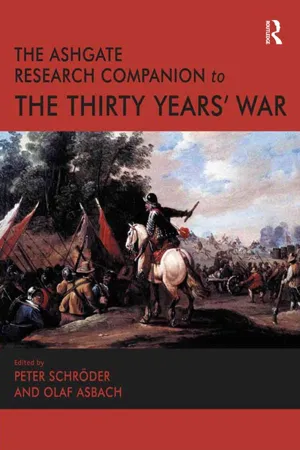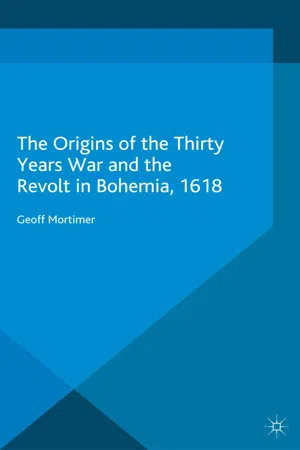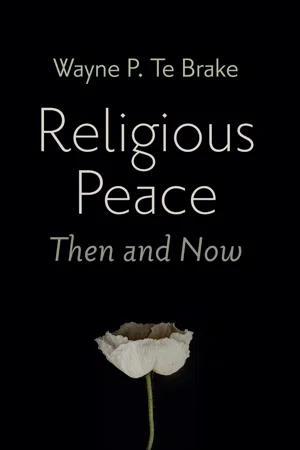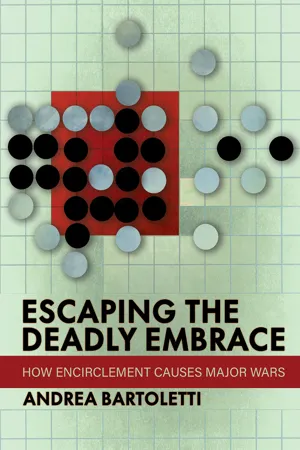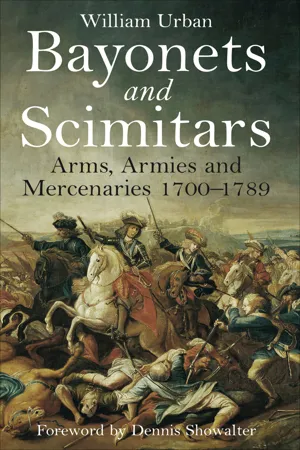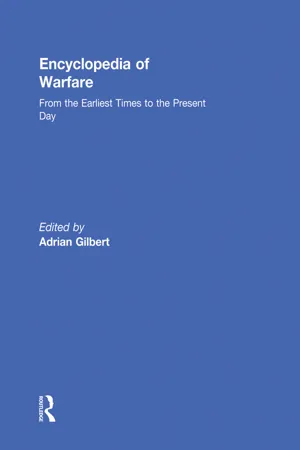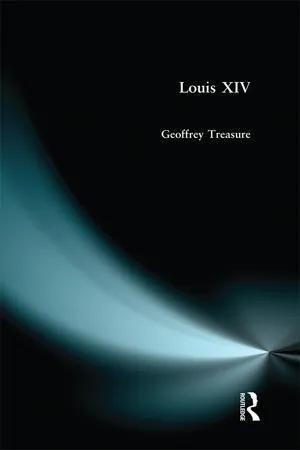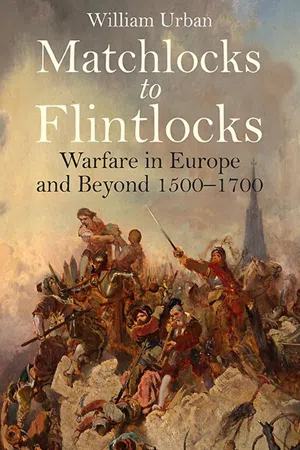History
The Thirty Years War
The Thirty Years' War was a conflict fought in Central Europe from 1618 to 1648, primarily between Protestant and Catholic states. It was one of the most destructive and longest continuous wars in history, resulting in significant political and territorial changes. The war had a profound impact on the balance of power in Europe and led to widespread devastation and suffering.
Written by Perlego with AI-assistance
Related key terms
9 Key excerpts on "The Thirty Years War"
- Olaf Asbach, Peter Schröder(Authors)
- 2016(Publication Date)
- Routledge(Publisher)
The Thirty Years' War – An Introduction
Olaf Asbach and Peter Schröder DOI: 10.4324/9781315613666-1The Thirty Years’ War (1618–1648) remains a puzzling and complex subject for students and scholars alike. One might even ask whether the term ‘Thirty Years’ War’ is justified in the first place, since the war seems to dissolve into a series of individual conflicts with different issues, often with no real common denominator, and different participants, without any clear beginning or end. One might thus think of the European conflicts as, for instance, the war between Sweden and Poland1 or the struggle between France and the Spanish and Austrian Habsburgs for hegemony in Europe as being distinct episodes which cannot be conflated under a single label.1 See R.I. Frost, The Northern Wars 1558–1721 (Harlow, 2000).But there was one central issue which justifies the contemporary judgement that the ‘Thirty Years’ War’ was a contest with a definite beginning and a definite end and with a structure giving coherence to the various military campaigns, rather than simply an amorphous series of individual wars: the struggle for the constitution of the Holy Roman Empire and – inseparable from this question – the balance of political and religious forces in Central Europe. The beginning of this conflict was clearly a German war: at stake were internal issues of the empire. This conflict was increasingly internationalised, especially from 1630 onwards, when Sweden invaded the empire. Thus several phases can and have to be distinguished. However, until 1629 the conflict was essentially centred on the imperial constitution and the relationship between the confessions. The war was fought by German Protestants (Lutherans and Calvinists) and Catholics alike in order to enforce their own ‘authentic interpretation’ of the Peace of Augsburg (1555). This happened notably when the Emperor issued the Edict of Restitution in 1629, where it was claimed that the Edict was the authentic interpretation of the Peace of Augsburg. The war was thus manifold: about the empire, about religion and about power politics in Europe. This was also reflected in the Peace of Westphalia, a treaty which, after all, had the twofold aim of both settling international relations and of introducing a settlement for the empire, and all this by simultaneously, and fundamentally, changing the relationship between politics and religion.- Geoff Mortimer(Author)
- 2015(Publication Date)
- Palgrave Macmillan(Publisher)
1 The Origins of The Thirty Years War? The Thirty Years War was not only long, but also extremely complicated. Hence almost all modern histories of the war (with one recent exception 1) have sought to confine their accounts of the circumstances and events prior to the revolt in Bohemia to their first substantive chapter. Although there are differences in detail the overall approach is generally similar, outlining the increasing tensions and the specific incidents which by 1618 had created a critical situation in which a rebellion in Prague could lead to a prolonged and widespread conflict. English-speaking historians tend to stress the international context rather more than their German colleagues, even those who espouse the modern European view of the war, but this is a matter of emphasis rather than a difference of principle. Consequently this book too will set out a summary of the background to the war as Chapter 1, firstly in order to present the relevant facts conveniently and concisely, but secondly as the basis for a discussion in Chapter 2 of the validity of the standard interpretation. Arndt describes The Thirty Years War as ‘a European war, but one which took place predominantly on the soil of the Holy Roman Empire’. 2 The latter part of this observation is certainly true in a literal sense, as at that time the Empire still theoretically included not only Germany, Austria and the lands of the Bohemian crown, but also much of northern Italy, together with Franche-Comté, Alsace, Lorraine and the Spanish Netherlands, as well as the United Provinces (Dutch Republic) and indeed the Swiss Cantons, notwithstanding that both the latter territories had long since established their practical independence- eBook - ePub
- Wayne P. Te Brake(Author)
- 2022(Publication Date)
- Cascade Books(Publisher)
It still took until 1607 for a ceasefire to be arranged, and two more years before a Twelve Year Truce could be concluded in 1609, in lieu of a more permanent settlement. Then, for nearly a decade there were no active armed religious conflicts in Europe. By this time, throughout western and central Europe, durable patterns of religious diversity had replaced the religious “unity and purity” that had characterized Latin Christendom just a century earlier. This peace did not last, of course, and when it failed, it failed spectacularly! The Thirty Years War, the most destructive in European history prior to World War I, started in 1618 ; both the Eighty Years War and the French religious wars restarted in the 16 20 s; and the interconnected civil wars in Scotland, Ireland, and England began in 1638. 24 Only Switzerland was spared a recurrence. Together, these armed conflicts constituted the last, transnational phase of the religious wars on the Continent. In retrospect, historians typically characterize this early peace as particularly fragile and argue that more war was inevitable. But for our purposes, it is critical to recognize the contingency of each of these armed conflicts, because the recurrent mechanisms of activation, escalation, brokerage, and polarization combined to make religious war possible, but not inevitable - eBook - ePub
Cornell Studies in Security Affairs
How Encirclement Causes Major Wars
- Andrea Bartoletti(Author)
- 2022(Publication Date)
- Cornell University Press(Publisher)
This historiographic approach identifies domestic politics as the main level of analysis for understanding the internationalization of the conflict. The revolt of the Protestant Bohemians against the Catholic Hapsburg of Austria spread as each group tried to defend its religious liberty. The presence of different religious factions within European kingdoms prevented the isolation of separate conflicts, as each local minority feared that the victory of the religious adversary in another kingdom would undermine their ability to survive at home. Therefore, this argument considers domestic politics not only as the catalyst of the conflict but also as a powerful influence in foreign-policy decision making.The main alternative explanation for the origins of the Thirty Years’ War places the civil war within the Holy Roman Empire in the wider context of the European struggle between the French and the Hapsburg.9 Theories that stress the international character of the major war usually regard it as the last episode of the Hapsburg pursuit of European domination or as the Spanish attempt to stop its own inevitable decline by thwarting the rise of the French challenger.10 I accept the international characterization of the Thirty Years’ War as part of the French anti-Hapsburg struggle that characterized Europe from 1477 to 1713, but I argue that this major war was the consequence of the French attempt to prevent actualized encirclement by the Hapsburg powers of Spain and Austria.Focusing on the international character of the Thirty Years’ War calls into question not only the religious roots of the conflict but also its temporal boundaries.11 Conventional view is a “figment of retrospective imagination,” a crystallized myth that is nonetheless extremely difficult to deconstruct: “we are dealing with a European war during the thirty years 1618–48. But it is well known that war … did not end in 1648, and less well known that it did not begin in 1618.”12 According to this historiographic approach, the war started with the French direct military intervention against Spain in 1635 and lasted until Spain and France signed the Treaty of the Pyrenees in 1659.13 I concur with viewing the Thirty Years’ War as part of the French-Hapsburg rivalry, but based on the definition of major war that I formulated in chapter 1, I consider it to have lasted from the French declaration of war on Spain until the signing of the Peace of Westphalia (1635–1648).14 - eBook - ePub
Bayonets and Scimitars
Arms, Armies and Mercenaries 1700–1789
- William Urban(Author)
- 2013(Publication Date)
- Frontline Books(Publisher)
CHAPTER ONE
War in the Eighteenth Century
War in the Seventeenth Century
Everyone in central Europe remembered The Thirty Years War (1618–48) as one long nightmare of violence and destruction. The bloody battles in the Holy Roman Empire were followed by massacres, robbing, murdering, raping – Protestants sacking Catholic towns and villages, Catholics rampaging through Protestant communities, and both ignoring confessional identities when food and fodder were short. Marauding armies from Austria, Spain, France, Denmark and Sweden were trailed by life-hardened wives, washwomen, cooks and prostitutes, some performing all roles simultaneously; no army could survive without them. Each army was mobile, sustaining itself by looting every community in its way. One could not think of any of these armies except as a plague on everyone’s house.1 This plague then spread into the Low Countries (modern Belgium and Holland), to Poland and, in the form of civil war, to France and England.The war in Germany was declared over in 1648 by the Peace ofWestphalia, but recovery came slowly. France became the major power of Europe, while Poland, Austria and Spain declined. Minor powers manipulated the political situation for their own benefit – Sweden, Brandenburg-Prussia, Saxony and Holland being the foremost of a numerous host. Given this history, it comes almost as a surprise to see that by the end of the century the semi-disciplined armies of that era had evolved into something closer to their modern forms. This was the result of new technologies being applied to the art of killing and improved methods of training soldiers; also generals had accumulated experience in commanding large armies.The sizes of the new military establishments were much greater than they had been, and, because soldiers could no longer subsist on plunder, they were now supported by a logistical supply line and stores kept in safe fortresses. As a result, the disorderly life of the mercenary army evolved into that of disciplined camps and garrisons. In this process the role of women in warfare declined significantly. Lynn noted in Women, Armies and Warfare in Early Modern Europe - eBook - ePub
Encyclopedia of Warfare
From the Earliest Times to the Present Day
- Adrian Gilbert(Author)
- 2013(Publication Date)
- Routledge(Publisher)
The events of 1588 pointed the way with regard to naval warfare, though. The more maneuverable English ships avoided Spanish efforts to close and use their boarding tactics and the shock action of their large numbers of excellent infantry. Though the English did little damage due to their remaining at long ranges to avoid the heavy Spanish cannon (the latter included heavy cannon firing 50 lb [22.7 kilo] metal balls), they nevertheless scored far more hits. The success of English shipborne artillery signaled the emergence of a new type of naval warfare: broadside combats conducted by broad, deep sailing ships. In addition, the latter, having a greater cargo-carrying capacity than galleys, increased the overall scope of naval operations.The Thirty Years WarA semicomical episode in Prague in May 1618 sparked one of Europe’s most savage wars, which was to have a profound effect on the development of land warfare, both on the tactics used on the battlefield itself, and on the way armies were supplied during campaigns. The war was also to produce one of the most innovative generals of the early modern period: Gustavus Adolphus of Sweden.T he Thirty Years War was partly an internal struggle for the succession to power within the unwieldy Holy Roman Empire, partly an ideological struggle between Protestantism and Catholicism, and partly a dynastic struggle between the royal houses of Hapsburg, Vasa, and Bourbon.Germany at this time was not a united country, but a collection of 300 states that, nominally at least, acknowledged the overlordship of the Catholic Holy Roman Emperor. Conflict between the emperor and the various German states had been endemic throughout the Middle Ages, but the Reformation transformed these disputes, dividing Protestant and Catholic states into two competing power blocks. The Protestant Evangelical Union was opposed by the Catholic League, and the combination of religious fervor and political ambition formed a powder keg – ignited by the so-called Prague defenestration crisis of May 1618. On the 22nd of that month, a group of Protestants threw two of the Holy Roman Emperor’s advisors and an official out of a window as an expression of their outrage at Emperor Mathias’s decree that ended the toleration of the Protestant religion in the empire. The victims were unhurt by their falls, as they landed on a large, fresh pile of dung! - 9 Later, as the value of colonies was perceived and commercial interests became more influential, economic factors become more prominent.In each war, of course, there were allies with different agendas. Within both countries there were differences over war aims and priorities: in 1701-13, for example, in France about the use of the navy; in England over the costly commitment to continental war. The overall aims of statesmen were, in any case, affected more by traditional values, personal rivalries — and, England's case, by party positions, than may be allowed for in the historian's overview. The most significant group of dissidents in France, the circle of the duke of Burgundy, would espouse a programme as reactionary as it was idealistic. Even in England, countering traditional opposition to standing armies, Marlborough's victories started a minor cult of military glory. Blenheim would be England's Versailles. Less rigid towards the end than his enemies, Louis showed an unexpected ability to trim and adjust in the face of adversity. Reaching, in distress, for a voice to reach his people, he remained the dynast, his view patrimonial: the state was his domain. In the way they came about, were fought, and concluded, the wars of 1689 to 1714 seem to have more in common with the past than with the future. But there are features that anticipate later developments, in the nature of war and its impact on government and society.The Nine Years War — or War of the League of Augsburg as it is otherwise called — was to prove intense and wide-ranging, with aspects pointing towards the 'total' war of modern times. With ever-larger forces available on both sides, a significant naval dimension, and improved ways of raising money, there was a closer relationship between financial and administrative structures, and the fighting efforts of the major powers. The creation of the Bank of England in 1694, and the credit consequently made available, played a vital part in the defeat of France in a war of resources. The wealth that was making London the financial centre of Europe made England the banker of the coalition. The interacting process of war and state-building can be studied at the fringe, in the wars of the north, in the enlargement of government and new military potential of Brandenburg and Russia, and – providing an object lesson in the penalty for failing to develop – the relative powerlessness of Poland.
- eBook - ePub
The Emergence of Modern Europe
c. 1500 to 1788
- Britannica Educational Publishing, Heather Campbell(Authors)
- 2010(Publication Date)
- Britannica Educational Publishing(Publisher)
CHAPTER 3 THE THIRTY YEARS ’ WAR , 1618–48T he war originated with dual crises at the Continent’s centre: one in the Rhineland and the other in Bohemia, both part of the Holy Roman Empire.“The dear old Holy Roman Empire,How does it stay together?”asked the tavern drinkers in Goethe’s Faust —and the answer is no easier to find today. The Holy Roman Empire of the German Nation was a land of many polities. In the empire there were some 1,000 separate, semiautonomous political units, many of them very small, and others comparable in size with smaller independent states elsewhere, such as Scotland or the Dutch Republic. At the top came the lands of the Austrian Habsburgs, covering the elective kingdoms of Bohemia and Hungary, as well as Austria, the Tyrol, and Alsace, with about 8,000,000 inhabitants; next came electoral Saxony, Brandenburg, and Bavaria, with more than 1,000,000 subjects each; and then the Palatinate, Hesse, Trier, and Württemberg, with about 500,000 each.These were large polities, indeed, but they were weakened by three factors. First, they did not accept primogeniture: Hesse, for instance, had been divided into four portions at the death of Landgrave Philip the Magnanimous in 1567. Second, many of the states were geographically fragmented. These factors had, in the course of time, created in Germany a balance of power between the states. The territorial strength of the Habsburgs may have brought them a monopoly of the imperial title from 1438 onward, but they could do no more: the other princes, when threatened, were able to form alliances whose military strength was equal to that of the emperor himself. However, the third weakness—the religious upheaval of the 16th century—changed all that: princes who had formerly stood together were now divided by religion. Swabia, for example, more or less equal in area to modern Switzerland, included 68 secular and 40 spiritual princes and also 32 imperial free cities. By 1618 more than half of these rulers were Catholic; the rest were Protestant. - eBook - ePub
Matchlocks to Flintlocks
Warfare in Europe and Beyond, 1500–1700
- William Urban(Author)
- 2011(Publication Date)
- Frontline Books(Publisher)
Rocroi was the turning point in the war, ending a century of Spanish domination of the battlefields of Europe. This was not immediately apparent, however, because France itself was on the verge of dissolution – the first Fronde was in the making.The Impact of The Thirty Years War on Germany
The war removed the fiction that Germany was a unified nation. Several German states were now closely associated with neighbouring non-German lands, the emperor was not trusted, the Church was divided, tariff barriers hindered trade, petty lords ground down their peasants, and proposals for imperial reform barely got a hearing. Germany was a geographical expression, a place where princes could scheme at inheriting new lands, bargain for their loyalty, and dream of a return to days when they could hunt safely in their many woods, listen to good musicians and even burn a few witches. It would take Louis XIV’s aggression late in the century to revive national feelings, but when those wars ended, so too did the patriotic feelings.Even so, memory of the destructiveness of The Thirty Years War lingered in Germany for generations.19 The physical damage was made good sooner, though estimates of human losses run as high as a third of the population in some regions, and property damage can hardly be calculated. In Swords for Hire James Miller writes eloquently about the cycle of hungry, cold and poorly clothed soldiers taking what they needed from the peasants, the peasants murdering soldiers whenever they felt safe to do so, and the soldiers taking brutal revenge later (perhaps on completely different communities). Soldiers storming towns massacred those who had not surrendered promptly, causing their enemies, when the roles were reversed, to slaughter them even as they tried to yield.What did the many female camp followers think about the robbery and rapes? Did female solidarity come into play? Probably not. The camp followers, whether prostitutes, whores (cohabiting for the duration of a campaign) or wives, seem to have been more voracious plunderers than the men; as for rape, they seem to have looked upon that as one of the fortunes of war, perhaps even witnessed it with some satisfaction – providing them a sense of revenge for similar humiliations inflicted by the enemy.20
Index pages curate the most relevant extracts from our library of academic textbooks. They’ve been created using an in-house natural language model (NLM), each adding context and meaning to key research topics.
